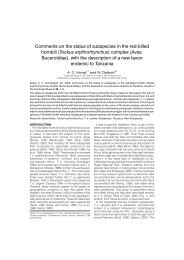EAZA Hornbill Management and Husbandry Guidelines
EAZA Hornbill Management and Husbandry Guidelines
EAZA Hornbill Management and Husbandry Guidelines
You also want an ePaper? Increase the reach of your titles
YUMPU automatically turns print PDFs into web optimized ePapers that Google loves.
M. Kinnaird (Sheppard <strong>and</strong> Worth, 1997) found that sealing material of great hornbills<br />
Buceros bicornis largely consisted of their high-fiber fecal material (see Section 5.1.4:<br />
Fiber), compared to captive hornbills, which frequently plaster the entrance with sticky,<br />
soft food items. Kinnaird <strong>and</strong> O’Brien (1997) noted that figs in the plastering matrix of<br />
Sulawesi wrinkled hornbills Aceros cassidix function as limestone gravel in concrete.<br />
Items such as bananas, figs, boiled (not too soft) potatoes, boiled yam, soaked Bird of<br />
Prey diet <strong>and</strong> minced meat are used in captivity. Mud, pottery clay, riverbank clay <strong>and</strong><br />
the hornbills’ own (relatively low fiber) feces have also been mentioned in breeding<br />
reports. Elephant <strong>and</strong> horse feces, soil, saw dust, straw, peat, insects (cockroaches <strong>and</strong><br />
bumblebees) have been worked into sealing mixtures by hornbills, <strong>and</strong> do provide fiber.<br />
Materials placed in the nest can serve for plastering as well as lining materials (see<br />
Section 6.3.5: nest lining). Each pair may have its own preferences, <strong>and</strong> offering a variety<br />
of potential plastering materials could stimulate nesting activity. If the nest entrance is<br />
appropriate in form <strong>and</strong> thickness <strong>and</strong> sealing material falls out of the opening, other<br />
materials should be offered.<br />
The shape <strong>and</strong> size of the nest entrance can greatly affect the hornbills’ ability to seal the<br />
nest. The larger the opening the more difficult sealing it is. A square or rectangle nest<br />
opening is more difficult to seal then an essentially diamond or oval shaped opening.<br />
Shape of nest entrances used by four hornbill species in Thail<strong>and</strong> are shown in Appendix<br />
11.G. A thin material is more difficult than a thick one (minimally 3 cm wall thickness is<br />
recommended). Straight edges are more difficult to seal than uneven edges <strong>and</strong> smooth<br />
edges more difficult than rough edges (A. Kemp, pers. comm.). Hemp rope has been<br />
attached to the inner edge of the nest opening at some zoos, including Audubon Park Zoo<br />
(Reilly, 1988; Uzee Sigler <strong>and</strong> Myers, 1992), to provide anchorage when plastering<br />
materials could not adhere to the nest opening. Attaching extra wood around the entrance<br />
to make it thicker has also worked in some cases.<br />
6.3.5 Nest lining<br />
Both males <strong>and</strong> females bring lining to the nest, <strong>and</strong> males may continue to do so after<br />
the entrance is sealed. Nest lining can help to control nest humidity, <strong>and</strong> provides a soft<br />
substrate <strong>and</strong> a means to sanitize the nest through removal of soiled material. Nest lining<br />
can be adjusted by the female <strong>and</strong> young to raise or lower the height of the cavity. Some<br />
species prefer a moist lining, such as green leaves <strong>and</strong> grass, while others prefer dryer<br />
materials, e.g. bark flakes <strong>and</strong> dry leaves. Some materials may have anti-parasitic <strong>and</strong><br />
anti-pathogenic properties, but this must be tested (Kemp, 1995).<br />
<strong>Hornbill</strong> managers at Audubon Park Zoo have a schedule for changing the nest substrate<br />
a couple of weeks before breeding of a given species is anticipated (Appendix 11.F). The<br />
substrate used at Audubon Park Zoo for all the hornbills is a combination of<br />
approximately equal portions of moist potting soil, wood (pine) shavings <strong>and</strong> sphagnum<br />
moss. Enough potting soil is added that the mixture holds together fairly well when<br />
compressed in the h<strong>and</strong>. The lining is thought to be quite important to general health<br />
survival of the chicks.<br />
50




